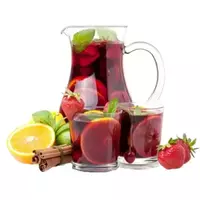Sangria

The famous Spanish drink Sangria appeared in the 19th century. Fruit pickers in Spain and Portugal have become the inventors of a modern version of the wine-based drink, with the addition of water, fruits or juices, as well as sugar, spices, carbonated and soda water, a small amount of liquor or brandy. Sangria allowed workers more time under the scorching sun, quenched thirst and refreshed, gave vigor, but at the same time did not drink.
Interesting is the name of the drink Sangria, which came from the Spanish word sangre or blood. Sangria is believed to have been known as early as the 17th, however, its recipe was not similar to a modern low-alcohol drink. In one of the provinces of Spain, peasants for a long time could not get a good grape harvest. The landowner was unwilling to listen that the poor harvest was a consequence of the prolonged dry weather. He ordered a massacre of peasants.
The winemakers went to the trick to protect themselves from the inevitable bloodshed, they made a punch based on red wine and fruits, and to increase the strength and sweetness, the peasants added sugar to the drink. Since then, the richly red wine drink is believed to have been named Sangria, which means blood, after the victims and the dead.
The invention of Sangria is disputed by Italy. The state believes that the first Sangria was made by the Italian retired soldier Helio Gabal, who lived in Spain for a long time and tried to create citrus wine. The poor fellow did not succeed for a long time and at the minute of despair Helio cut the orange into mugs and added citrus to the jug of red wine.
The Spaniards tried a new drink and exclaimed that it was like the blood of the devil. Sangria became popular, but the Italian was declared in worship of Satan and burned at the stake as a heretic. Only decades later, the Holy Inquisition lifted the ban on the use of Sangria. To this day, Italy has its own Sangria, which is cooked with sparkling wines, pieces of fruit, spices and juice.
In modern times, the following species of Sangria exist:
Quiet Sangria, such a low-alcohol and refreshing drink must have grapes and soda water.
Fruit sangria, which includes a variety of fruits (citrus, grapes, apples, strawberries, peach and banana).
White sangria is made on the basis of white wine varieties.
Sparkling wine sangria.
What is noteworthy is that until the 19th century in Europe nothing was known about Sangria. It was a drink that was consumed mainly in the southern part of the region, such countries as Spain, Italy and Portugal. Only in the 70s of the last century did Sangria seriously talk all over the world. This drink became a symbol of that era, as well as hippie's Children of Flowers, the Cold War, the confrontation of the powers and man's first acquaintance with space.
sangria 173 kKal
Energy value of sangria (Ratio of proteins, fats, carbohydrates - ju):
Proteins: 0.27 g (~ 1 kCal)
Fats: 0.07 (~ 1 kCal)
Carbohydrates: 22.59 g. (~ 90 kCal)
Energy ratio (bj | y): 1% | 0% | 52%
 Español
Español Français
Français Português
Português Русский
Русский 简体中文
简体中文 繁體中文
繁體中文 日本語
日本語 한국어
한국어 العربية
العربية Türkçe
Türkçe Қазақ
Қазақ Deutsch
Deutsch Italiano
Italiano Українська
Українська
